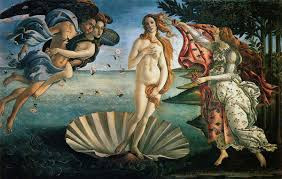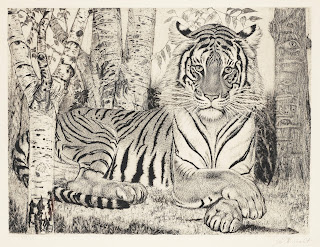 |
| CLAUDE MONET - Impression sunrise - 1872 |
He was a founder of French impressionist painting. Monet's ambition of documenting the French countryside led him to adopt a method of painting the same scene many times in order to capture the changing of light and the passing of the seasons.
2.
 |
| JAN VERMEER Girl with a pearl earring - 1665 |
Considered by many to be “the Dutch Mona Lisa” or the “Mona Lisa of the North”, this beautiful painting by the Dutch artist Johannes Vermeer features, well… a girl with a pearl earring. The painting was completed around 1665 and is on display in the Mauritshuis Gallery in the Hague, the Netherlands. He specialized in domestic interior scenes of middle-class life. Vermeer was a moderately successful provincial genre painter in his lifetime. He evidently was not wealthy, leaving his wife and children in debt at his death, perhaps because he produced relatively few paintings.
3.
The Kiss is a realistic yet geometric depiction of a kissing couple. Klimt is noted for his paintings, murals, sketches, and other objets d'art. Klimt's primary subject was the female body.He was the most influenced by Japanese art and its methods.
 |
| GUSTAV KLIMT The kiss - 1908 |
Where: Osterreichische Galerie, Vienna (Austria)
Oils and golden leaves
9.
He was a Russian painter and art theorist. He is credited with painting one of the first recognised purely abstract works.
5.
 |
| EDVARD MUNCH The scream - 1893 |
The Scream exists in four versions: two pastels (1893 and 1895) and two paintings (1893 and 1910). There are also several lithographs of The Scream (1895 and later). It has been widely interpreted as representing the universal anxiety of modern man. Munch wrote of how the painting came to be: "I was walking down the road with two friends when the sun set; suddenly, the sky turned as red as blood. I stopped and leaned against the fence, feeling unspeakably tired. Tongues of fire and blood stretched over the bluish black fjord. My friends went on walking, while I lagged behind, shivering with fear. Then I heard the enormous, infinite scream of nature."
Where: National Gallery, Oslo
Value: $123 mln. The Scream was once stolen and the thieves left a note "Thanks for the poor security."
It was painted using oil and pastel on cardboard.
6.
Located on the ceiling of The Sistine Chapel in Vatican City, Rome. The Creation Of Adam was painted by Michelangelo between 1508 and 1512 and it is just one of nine scenes from the book of Genesis that are painted on the center of the ceiling of the chapel.
 |
| LEONARDO DA VINCI The last supper - 1498 |
7.
Value: $143 mln.
8.
Where: Museum of Modern Art, New York, the USA
 |
| PIERRE AUGUSTE RENOIR Dancing at the Moulin de la Galette - 1876 |
Value: $143 mln.
8.
 |
| SALVADOR DALI The persistence of memory - 1930 |
The Persistence of Memory is one of the most recognizable pieces in art history. This work of art is known to make people ponder on their way of life and the way they spend their time, and it is also thought that this wonderful painting was inspired by Albert Einstein’s Theory of Relativity.
9.
 |
| WASSILY KANDINSKY Composition VIII - 1923 |
10.
This painting by Van Gogh is an interesting piece because it shows the artist without his beard. It is also one of the few paintings sold by Van Gogh, and it fetched a whopping $71.5 million in 1998, making it one of his most expensive paintings ever sold.
 |
| VINCENT van GOGH "Portrait de L’Artiste Sans Barbe" |
11.
 |
| PABLO PICASSO "The Portrait of Dora Maar"
Pablo Picasso is one of the most accomplished Spanish painter, and his skill is most evident in this painting. He is the founder of a style called Cubism that shows the same picture from different angles. This picture is about a woman’s face, believed to that of Picasso’s lover, shown from different angles, thereby marking the first of many paintings in cubism style.
12.
EDUARD WIIRALT "
Eduard Wiiralt (born March 20, 1898, Saint Petersburg – died January 8, 1954, Paris) was a well-known Estonian graphic artist.
13.
KONRAD MÄGI "Landscape of Vilsandi"
Konrad Vilhelm Mägi (1 November 1878 – 15 August 1925) was an Estonian painter, primarily known for his landscape work. He was one of the most colour-sensitive Estonian painters of the first decades of the 20th century, and Mägi's works on motifs of the island of Saaremaa are the first modern Estonian nature paintings.
14.
NAVITROLLA
Heiki Trolla (born 10 August 1970 in Võru[1]), better known by his artist name Navitrolla, is an Estonian painter whose work has been described as naivist or surrealist. Most of his works depict fantastic landscapes and animals. He spent his childhood in the villages of Trolla and Navi near Võru, which is the source of his pseudonym.
15.
PAUL CEZANNE "The Basket of Apples"
Cezanne is considered the greatest master of still life painting and this is one of his most important works in the genre. It is also noted for the beautifully painted unbalanced parts and the fruits which are about to fall from the table.
|




